Last century, back in 1984, I clicked through an entire roll of film, shooting cars on the Southern Motorway, with my camera shutter locked open. The tail lights ahead were jiggling like demented glow worms as we tried in vain to keep our vehicle steady. From these long exposures, only one frame was any good, but I was hooked.
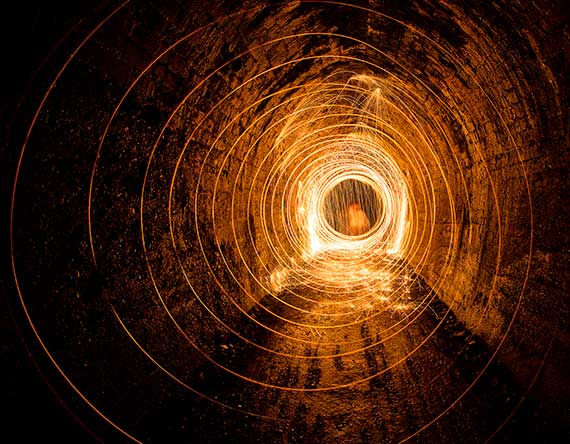
“Spiral at Spooners.” Moving toward the camera while spinning steel wool creates a vortex.
Fast-forward to the digital era, where everyone and their DSLR is saturating social media with stunning images. How do you stand out from the proverbial crowd? One answer is to shoot at night time, when sensible folks are at home sleeping. Familiar objects will appear remarkably different under the cover of darkness, so you can put a different ‘spin’ on them.
The literal definition of the Greek words photos and graphos is to ‘paint with light’. So, by definition, if you practice photography, you’re light painting; you are producing art.
In this first tutorial, I will show you how to spin wire wool to create arty, abstract photos that exude that elusive ‘wow factor.’
Location
Find a suitable plot of ground, devoid of vegetation, vehicles, or flammable material. Think concrete, netball courts, train tunnels, or under a bridge. Spinning steel wool will bounce off the walls of a closed-in space, such as a tunnel, sending random sparks flying. While this is a neat effect, your surroundings should be damp so stray sparks don’t get you in trouble. Err on the side of caution.
Alternatively, a calm pool of water will reflect the spinning orb of light. Sparks may bounce off the water—another cool effect. Gumboots are a godsend. For practical and safety reasons, it is imperative that you have an assistant.
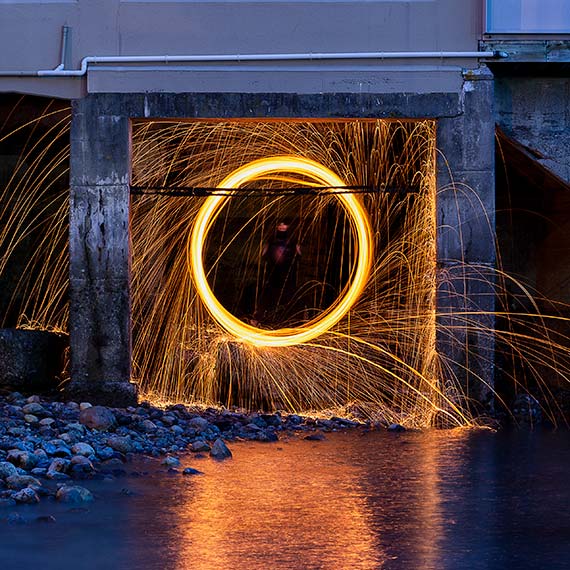
“Whisk Management.” Contrasting colors and shapes make for a dramatic image.
Timing
If you fail to plan, you’re planning to fail. Just like comedy, timing is critical. Set up during the daylight, so you can scout for a decent composition. It’s best to set up your camera on a stable tripod well before dusk, and pre-focus on your subject before auto-focusing becomes impossible.
The ideal time to shoot is during the Blue Hour—more specifically, half an hour after sundown, when the sky darkens to a deep blue—perfect for a contrasting backdrop. Indeed, blue is the complementary color of the burning orange orb you will be spinning. My rule of thumb is to start the shoot 20 minutes after sunset, so you can make several attempts during this 10-minute window. If you shoot after twilight, the background elements of the scene will disappear into darkness, and the resulting photograph will lose context.
Composition
Spinning wire wool creates a circle of fire. Ask yourself, “How can this geometric shape relate to the surrounding landscape?” For my iconic image shot at Lake Rotoiti, I made a long exposure of the stars circling the Southern Celestial Pole then mimicked these concentric circles by spinning the wire wool.
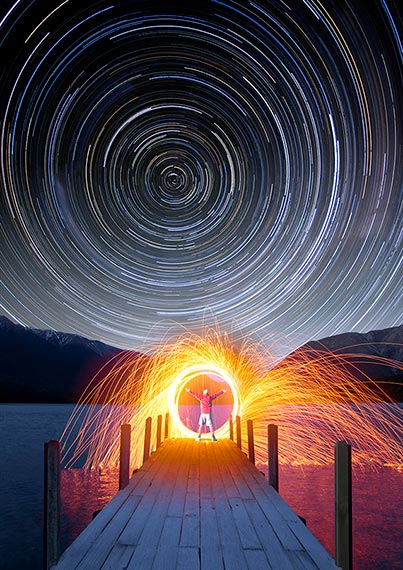
“Let there be light.”
Ask yourself, “Do I want to appear in the photograph?” If not, wear black clothing, gloves, and a balaclava.
Camera Settings
Once you have a composition planned, lock down the camera on a sturdy tripod. Hang a small LED light from the tripod to make it visible. Focus on where the fire-spinner will stand, then switch to manual focus on the lens barrel. A wide-angle lens is preferable.
Set the camera’s mode dial to Manual, with a shutter speed between 20 and 30 seconds. Apertures can vary from f/2 to f/11. Set the ISO between 50 and 800. Any higher and digital noise may become an issue. For color temperature, choose a ‘Daylight’ setting, or drop the Kelvin temperature down to about 3500K.
If you’re the photographer, wait for your assistant to light the wire wool and begin spinning it in a circle, then fire the shutter. Both of you should switch off your headlamps so they don’t interfere with the photo. To mitigate light leaking into the viewfinder, hang a baseball cap over the top of the camera.
Equipment
- A DSLR camera with manual mode and low-noise capability is preferable. However, many compact cameras will be suitable, providing they have manual focus and a long enough shutter speed. Use the humble self-timer as a poor man’s shutter release.
- A cable release or remote timing device is useful, so you don’t accidentally bump the camera.
- Fire extinguisher
- Safety goggles
- Gloves
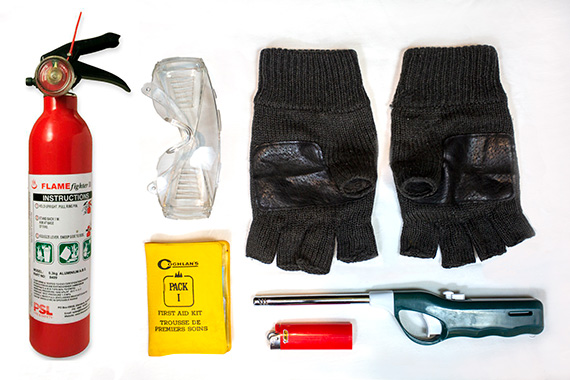
Safety Equipment
- Headlamp with fresh batteries. Carrying a spare torch is a wise precaution.
- BBQ firelighter or cigarette lighter. A 9 volt battery will also work.
- Fine grade steel wool. Steel wool comes in several grades. The super fine grade, labeled ‘0000,’ burns fast. The very fine grade ‘00’ gives off more sparks and burns longer, for about 25 seconds.
- Spinning device. A 25 centimeter egg whisk can be purchased from a Two Dollar shop for $2.50. Get the steel version, not the plastic! Attach the kitchen whisk to a length of chain, skipping rope, or a dog lead about one meter long, using a carabiner or similar bolt.
- Warm clothing
- Food and drink, especially if you’re in a remote location
Technique
- Pull apart a wire-wool pad length-wise to break up the density and allow oxygen inside. Unraveling the wool then spinning it speeds up the chemical reaction.
- Insert a wool pad into the whisk, ensuring it won’t fall out.
- When igniting the wire wool, a BBQ butane lighter is preferable for a continuous flame, whereas a cigarette lighter is fiddly and hard to operate with cold hands.
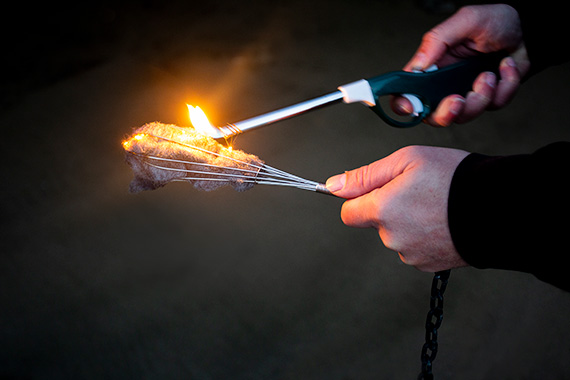
Lighting Steel Wool
- The wire wool will not burst into flames, only simmer. Once the wire wool has caught alight, spin the whisk in consistent circles. Then get the photographer to begin the long exposure.
- Keep your arm straight to create a perfect circle. Consistency is the key. Try not to move your body or you will appear as a blur.
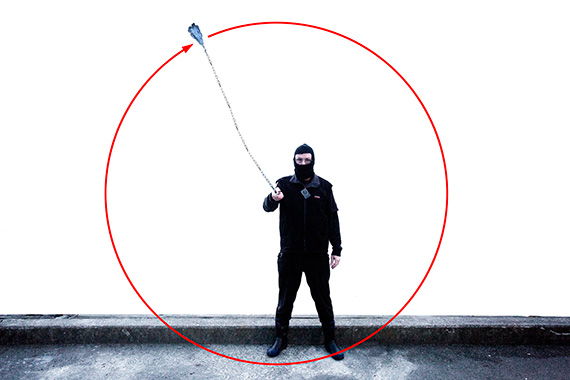
Be consistent when spinning the whisk.
If you need more inspiration, there are a tons of tutorials on YouTube. And there are numerous variations of this technique, from orbs to spheres to halos to a vortex.
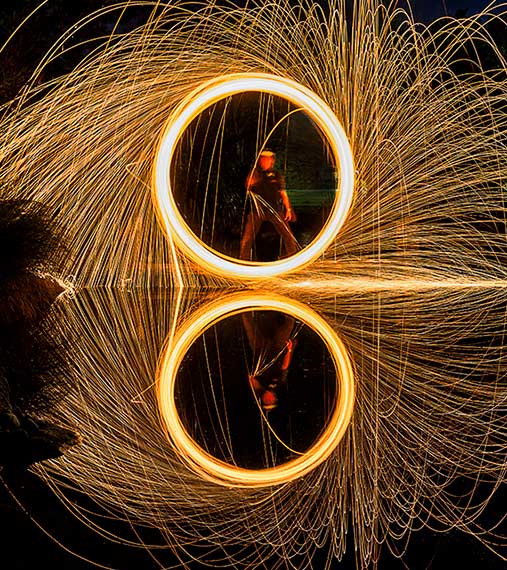
“Spinning Wool.” Repetition of geometric shapes through use of reflections
Because this is an experimental art-form, be prepared for lots of trial and error, especially the latter. As Ansel Adams remarked, “Landscape photography is the supreme test of the photographer, and often the supreme disappointment.” This is a challenging genre of photography with many inherent difficulties to overcome, but the rewards are there for the patient photographer.
About the Author:
Ray Salisbury is a seasoned landscape photographer and art teacher based in Nelson. He sells his photos to magazines, calendars, and image libraries. Would you like to fast-track your photography? Ray has created a series of online courses (including one on wire wool photography), where you can learn photography at your own pace. Leave the stuffy classrooms behind.
Like This Article?
Don't Miss The Next One!
Join over 100,000 photographers of all experience levels who receive our free photography tips and articles to stay current:






Leave a Reply